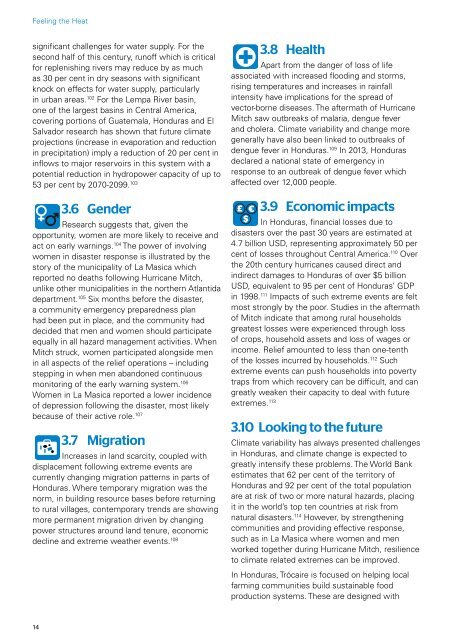trocaire-climate-change-report-2014
trocaire-climate-change-report-2014
trocaire-climate-change-report-2014
You also want an ePaper? Increase the reach of your titles
YUMPU automatically turns print PDFs into web optimized ePapers that Google loves.
Feeling the Heat<br />
significant challenges for water supply. For the<br />
second half of this century, runoff which is critical<br />
for replenishing rivers may reduce by as much<br />
as 30 per cent in dry seasons with significant<br />
knock on effects for water supply, particularly<br />
in urban areas. 102 For the Lempa River basin,<br />
one of the largest basins in Central America,<br />
covering portions of Guatemala, Honduras and El<br />
Salvador research has shown that future <strong>climate</strong><br />
projections (increase in evaporation and reduction<br />
in precipitation) imply a reduction of 20 per cent in<br />
inflows to major reservoirs in this system with a<br />
potential reduction in hydropower capacity of up to<br />
53 per cent by 2070-2099. 103<br />
3.6 Gender<br />
Research suggests that, given the<br />
opportunity, women are more likely to receive and<br />
act on early warnings. 104 The power of involving<br />
women in disaster response is illustrated by the<br />
story of the municipality of La Masica which<br />
<strong>report</strong>ed no deaths following Hurricane Mitch,<br />
unlike other municipalities in the northern Atlantida<br />
department. 105 Six months before the disaster,<br />
a community emergency preparedness plan<br />
had been put in place, and the community had<br />
decided that men and women should participate<br />
equally in all hazard management activities. When<br />
Mitch struck, women participated alongside men<br />
in all aspects of the relief operations – including<br />
stepping in when men abandoned continuous<br />
monitoring of the early warning system. 106<br />
Women in La Masica <strong>report</strong>ed a lower incidence<br />
of depression following the disaster, most likely<br />
because of their active role. 107<br />
3.7 Migration<br />
Increases in land scarcity, coupled with<br />
displacement following extreme events are<br />
currently changing migration patterns in parts of<br />
Honduras. Where temporary migration was the<br />
norm, in building resource bases before returning<br />
to rural villages, contemporary trends are showing<br />
more permanent migration driven by changing<br />
power structures around land tenure, economic<br />
decline and extreme weather events. 108<br />
3.8 Health<br />
Apart from the danger of loss of life<br />
associated with increased flooding and storms,<br />
rising temperatures and increases in rainfall<br />
intensity have implications for the spread of<br />
vector-borne diseases. The aftermath of Hurricane<br />
Mitch saw outbreaks of malaria, dengue fever<br />
and cholera. Climate variability and <strong>change</strong> more<br />
generally have also been linked to outbreaks of<br />
dengue fever in Honduras. 109 In 2013, Honduras<br />
declared a national state of emergency in<br />
response to an outbreak of dengue fever which<br />
affected over 12,000 people.<br />
3.9 Economic impacts<br />
In Honduras, financial losses due to<br />
disasters over the past 30 years are estimated at<br />
4.7 billion USD, representing approximately 50 per<br />
cent of losses throughout Central America. 110 Over<br />
the 20th century hurricanes caused direct and<br />
indirect damages to Honduras of over $5 billion<br />
USD, equivalent to 95 per cent of Honduras’ GDP<br />
in 1998. 111 Impacts of such extreme events are felt<br />
most strongly by the poor. Studies in the aftermath<br />
of Mitch indicate that among rural households<br />
greatest losses were experienced through loss<br />
of crops, household assets and loss of wages or<br />
income. Relief amounted to less than one-tenth<br />
of the losses incurred by households. 112 Such<br />
extreme events can push households into poverty<br />
traps from which recovery can be difficult, and can<br />
greatly weaken their capacity to deal with future<br />
extremes. 113<br />
3.10 Looking to the future<br />
Climate variability has always presented challenges<br />
in Honduras, and <strong>climate</strong> <strong>change</strong> is expected to<br />
greatly intensify these problems. The World Bank<br />
estimates that 62 per cent of the territory of<br />
Honduras and 92 per cent of the total population<br />
are at risk of two or more natural hazards, placing<br />
it in the world’s top ten countries at risk from<br />
natural disasters. 114 However, by strengthening<br />
communities and providing effective response,<br />
such as in La Masica where women and men<br />
worked together during Hurricane Mitch, resilience<br />
to <strong>climate</strong> related extremes can be improved.<br />
In Honduras, Trócaire is focused on helping local<br />
farming communities build sustainable food<br />
production systems. These are designed with<br />
14


